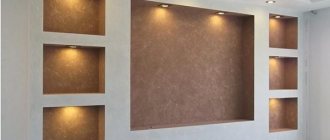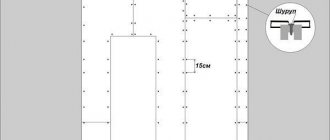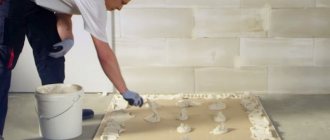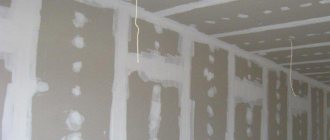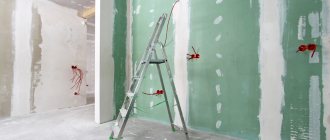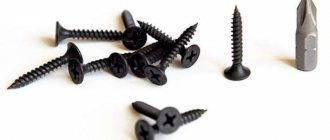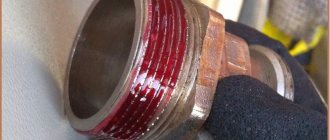When carrying out repair and construction work, plasterboard is often used, a material that can be called universal. It is used to construct partitions, when leveling walls and ceilings, and, if necessary, to create an unusual, very attractive ceiling structure of one or several tiers. But gypsum board sheets are quite heavy; lifting them alone and installing them correctly is often difficult. That is why it is recommended to use special lifts for drywall or a carrying handle, which greatly simplifies the work and makes it faster.
Diagram of the installation of a plasterboard sheet.
These portable slab tools perform the following functions:
- Lifting to the required height and fixing plasterboard sheets in the required position. The most popular are lifts that lift slabs in a horizontal position to the required height when installing suspended ceilings.
- Carrying drywall to the work site using simple and very comfortable handles.
- Holding the free edge during installation, quickly moving the sheet and lifting it.
Devices for hassle-free carrying
A variety of devices are used today to carry plasterboard sheets. They all differ in their design, size, and purpose. But they have one thing in common - the ability to speed up work, ensure transportation and lifting of plasterboard sheets to the required position.
Diagram of a drywall lift.
Today the following devices are used for transporting slabs:
- carrying handles for multiple sheets;
- wall lifts with fixing supports;
- lifts for ceiling work;
- universal devices for lifting and transportation;
- tables and carts that allow you to move and lift slabs to the required height;
- equipment designed for transportation and performing certain technological operations such as cutting, making holes, etc.
Some types of equipment are not only lifts, but also special spacer frames that allow you to quickly lift material. Such devices are used when installing single-level and complex suspended ceilings; they allow you to fix the position of the slab when they are attached with self-tapping screws to the profile or for the time required for the special adhesive composition to dry.
When working with these types of equipment, it is necessary to follow safety rules, as with any other construction equipment, remember that plasterboard boards have quite a significant weight, and if they fall, they can cause serious injury. Therefore, when loading, you should correctly calculate the weight of the sheets and do not stack more than is provided for by the operating rules. Otherwise, everything is simple and convenient.
Device for carrying drywall alone
A little earlier we mentioned the moment when it is necessary to install a heavy sheet of drywall onto the lift frame, without outside help. It is precisely for such cases that a special handle with a lock was invented, holding which in your hand you can easily pick up a sheet of any thickness and lift it without straining your lower back and back. The fact is that usually, when you place a sheet on its edge, you have to bend very low to put your fingers under the edge and jerk the material up. A drywall carrier allows you to do the same thing without bending over as much.
It’s not difficult to figure out how to use such a device. So, it is a strong frame with a handle at the top and a curved grip at the bottom. We need to move the sheet a considerable distance, but there is no one to wait for help. We stand with our right shoulder to the material placed on its edge, under the center of which the grip of the device has already been slipped. With our left hand we grab the top edge of the sheet, with our right hand we grab the handle, bending slightly and bending our legs. It is much easier to lift drywall from this position.
By the way, there is another problem. Again, it was said above that under a sheet placed on its edge you need to slip a device for carrying it. Consequently, it is still necessary to raise the material to a certain height, experiencing a certain load, which is not always feasible for the joints and muscles? Nothing happened. It is enough just to push from the side in one of the upper corners to create a small gap under the sheet and drive a foot counterweight into it, in the form of a pedal with a certain fulcrum, at the end of which there is a protrusion into which the drywall rests. This is another device that allows you to lift material to a height of up to 3 centimeters without applying absolutely any effort.
Carrying handles
Handles for transporting gypsum boards can only carry 1-2 sheets at a time.
Most often, a special carrying handle is used to transport drywall sheets, which can take a variety of shapes. You can only transfer one or two sheets at a time, but this is often enough to ensure a quick installation. The use of such handles is possible only by two people, that is, a set of two handles is used. The grip for the plasterboard sheet is carried out at a convenient height, while one free hand should hold the sheet in the correct vertical position.
There are variants of similar pens that are intended for single use, but here you can only transport one sheet.
This handle is used only for small volumes of repair and construction work, since carrying one sheet at a time will not reduce installation time. Therefore, it is recommended to use handles when renovating a private house, but for large areas it is best to give preference to special carts, tables and supports, which not only allow you to transport a large volume of material at a time, but also perform some of the technological operations necessary when preparing drywall for installation.
Marking the ceiling and fastening profiles using a lift
When installing a suspended ceiling is done in splendid isolation, difficulties are caused not only by the drywall, which somehow needs to be pulled up several meters, but also by the markings for the profiles. Why, installing the guides themselves is also very labor-intensive. The lift completely replaces an additional pair of hands, although it cannot play the role of a full-fledged assistant. In particular, a laser level can be easily attached to the frame using clamps or a magnet provided on the device
. It is unlikely that anyone has the ability to constantly direct a laser beam strictly in one plane while standing under the ceiling. The lift does not need rest.
Three-wheeled trolleys and supports
An example of using a three-wheeled cart and support.
When installing large volumes of drywall, it is recommended to use a device that allows you to move and lift sheets with a large weight. Typically this is very massive equipment with a lifting capacity of up to 400 kg. Such carriers serve to transport a package of sheets to a work site and are used during construction or repair work on a significant scale. All gypsum board sheets are laid on edge and have a slight slope. These are usually three-wheeled carts that are easy to move around the area.
Special trolley tables are also used, on which you can load up to twelve large sheets of drywall at a time. They are used for transportation and other technological operations related to the preparation of sheets for installation. The slabs can be cut on them and holes of the required size and shape can be made in them.
Mounting supports for drywall are devices that consist of a lever and a wooden movable stop, which allows for adjustment of the height of the gypsum board slab. Using such a device, you can hold the sheets in a vertical position, which is necessary when covering the walls of a room, when installing various partitions while they are being fastened with self-tapping screws, or when drywall adhesive is hardening. Such supports ensure reliable fixation of the sheet to the frame when raising it to the required height. This makes it possible to quickly and without damaging the edges of the sheet install a gypsum plasterboard of any size.
There is also a special device with which you can not only support the slabs in a vertical position, but also fix them if necessary. Such equipment with a stop-lock is considered more reliable and of higher quality, and its height can be only 80 cm.
Pedal devices provide lifting of the material; height adjustment is carried out using a pedal. This is not always convenient, since the installer’s actions are limited precisely by the need to press this pedal, so such equipment is rarely used for large-scale work.
Frame lifts
Frame lifts, used to lift plasterboard sheets, allow you to move plasterboard slabs vertically and horizontally and to fix gypsum boards when installing suspended ceiling structures. The lifting height of such a device can be different, but, as a rule, it is up to 3 m. The load capacity of such a device is about 50 kg, the weight of the lift itself is about 26 kg. With the help of such a device, even very complex work with drywall can be done alone.
The lifting process itself is very simple, and the movable base of the lift allows you to move the sheets to the position required for fixation. In addition, spacer lifts can be used, which greatly speed up all work.
Among the disadvantages, it is necessary to note the rather high cost of such a device, which often makes its purchase for home repairs simply impractical. In this case, you can make two simple T-shaped supports from metal (ordinary profile pipe) with your own hands. But such supports still require the participation of two people in installation. Therefore, if the volume of all planned work is not very large, then it is best to use special carrying handles. The handle makes it possible not only to transport, but also to lift the slabs to the required height.
When working with plasterboard boards, it is necessary to take into account not only their significant size, but also their weight, which makes installation alone becomes difficult and often simply impossible. Therefore, it is recommended to use special devices for carrying sheets, which allow you to quickly and easily transport gypsum boards to the required area of work and lift them to a certain height. Such equipment can be very diverse, depending on the requirements for the work process. They use special carrying handles, frame lifts, spacers and supports, pedal lifts and many other types of devices.
source: //www.vashgipsokarton.ru/montazh/prisposoblenie-dlya-perenoski.html
Drywall is a proven material that has earned a large number of positive reviews over many years of use. The scope of its application is huge and does not end with wall cladding or creating partitions. Not only professional builders, but most ordinary people are familiar with it firsthand. At the same time, few people know that drywall storage must be carried out according to certain rules, violation of which leads to deformation and damage to the material.
How to make your own drywall lift for installation work
Since the weight of the plasterboard used to finish the ceiling is almost 30 kg, difficulties may arise with the installation of such heavy material. In order not to overwork your hands and not turn to the help of friends, non-professional repairmen are recommended to use a drywall lift. This type of lift can be purchased or rented. However, if money is not allocated in the budget for purchases or borrowing a device, make a drywall lift with your own hands. In this article we will look at the design of such a mechanism and how to make it at home.
Structure of the material and principles of its storage
Drywall consists of two components, which appear in its name. The gypsum base is covered with a layer of paper, which tightens it and prevents it from cracking. This structure makes the gypsum sheet (gypsum board) resistant to serious longitudinal loads. At the same time, its lateral stability remains quite weak. Almost any pressure can lead to the formation of dents or even the appearance of through holes. Due to the large area of the sheet (2400x1200 mm), during the moving process its corners often suffer, breaking off or getting knocked down. According to building codes, the rules for storing drywall are based on the following principles:
- the storage temperature of the material should not fall below +10 degrees (the optimal values are 16-18 degrees);
- humidity in the premises should be 75-80%;
- a room with good working ventilation, ensuring the circulation of air masses of at least 3 cubic meters. m/hour per 1 sq. m area;
- a ventilation gap of about 10-15 cm is left between the sheets and the floor surface (to ensure the necessary conditions, the material is laid on wooden slats);
- the best option for storing drywall is a horizontal position with 3-4 points of support (you should not stack more than 15-25 sheets in one stack, since the lower sheets may burst due to the increased load);
- the laid sheets are covered with a film designed to protect them from construction debris or other types of pollutants.
Subject to the above conditions, the shelf life of the material is unlimited. At the same time, failure to comply with at least one point can affect the quality of drywall or even lead to its damage. Particular attention must be paid to the level of humidity and the absence of leaks, since the main enemy of gypsum boards is water.
It is best to store drywall in a room where you can organize all the necessary conditions for its safety. Storing material outside is a temporary measure and is carried out exclusively in the warm season. It is better to place it on the roof or attic, where it will be completely protected from precipitation.
It is not recommended to leave plasterboard outdoors for more than 1-2 days. In this case, the material must be hermetically sealed and placed according to all rules.
Improper storage and transportation features
The consequences of improper storage can be disastrous. Impaired air exchange in the room inevitably leads to increased humidity. Its increase to 85-90% promotes the formation of mold or condensation, which destroys the top paper layer of drywall. Not using plastic film leads to a similar effect. Dirt accumulates on the surface of the material, it becomes unprotected from external influences and moisture.
Neglecting installation rules leads to problems of a different nature. Placing gypsum boards on the floor without creating a support makes them unprotected from possible ingress of water, and also significantly reduces the quality of ventilation of the lower sheets. The absence of the necessary 3-4 points of support leads to deformation and sagging of the surface, which is due to low longitudinal stability and high weight of the material.
Transporting drywall is a potentially dangerous undertaking. The large surface area and its fragility often cause material damage. Loading and transporting sheets must follow the following rules:
- Transporting several sheets of drywall is carried out exclusively flat using a trolley.
- When loading into a car, special attention is paid to the edges, which easily crumble from the slightest impact.
- A special platform with 4-5 support points is installed in the body of the car, on which the material is placed (carrying it in a vertical position is strictly prohibited).
- Plasterboard sheets are stacked one on top of the other and carefully aligned relative to each other.
To transport a batch of drywall up to 25-30 units, such standards are more than enough. If you follow them, you can be sure that the material will reach the final point intact and safe. At the same time, at the time of unloading and bringing it to the site, you must be extremely careful, and having delivered it to the site, you should organize all the conditions for its high-quality storage.
